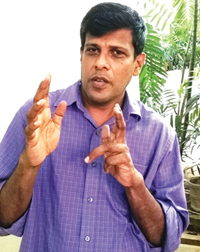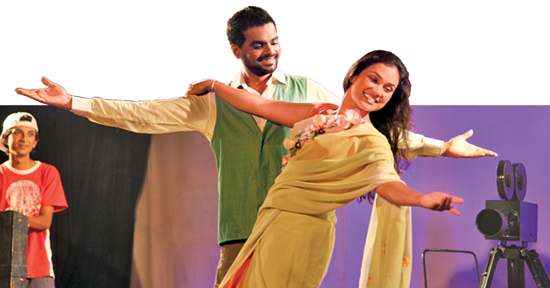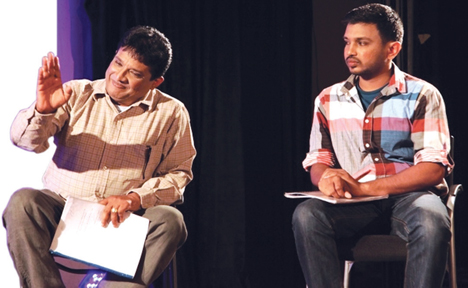Searching love’s veins not veneers
By Dilshan Boange
 Angelina Jolie says in the film Playing By Heart, “Talking about love
is like dancing about architecture.” The sheer nonsensicality in the
scheme of the comparison propounded in that line speaks volumes. Love as
a human emotion is possibly the most elusive feeling to define
objectively. This salient truth was expressed by Udayasiri Wickremaratne
in his latest creation Pem yuwalaka one kara thibe. (Wanted: a couple in
love). Angelina Jolie says in the film Playing By Heart, “Talking about love
is like dancing about architecture.” The sheer nonsensicality in the
scheme of the comparison propounded in that line speaks volumes. Love as
a human emotion is possibly the most elusive feeling to define
objectively. This salient truth was expressed by Udayasiri Wickremaratne
in his latest creation Pem yuwalaka one kara thibe. (Wanted: a couple in
love).
Sitting in the gentle darkness of the Tower Hall. I caught the
argument that was finally meted out by the young lovers towards the end
of the drama in a line spoken to the following effect Aadare therum
karanna baeha, aadaraya karanna vitharai puluwan.” (You can’t explain
love, you can only experience it).
In his latest play, ‘Pem yuwalak’ Wickremaratne offers a simple and
uncomplicated storyline, which however represents a rather complex and
onerous premise in respect of its theoretical aspects relating to the
art of acting. What is the play about?
In a nutshell, the story’s premise is, how a film director embarks on
a never before done venture in cinema, which is to cast an actual pair
of young lovers who have never before ‘acted the role’ of ‘lovers’ in
the hope of capturing for the silver screen ‘true love’ as can be shown
by actual lovers in real life. It’s a weighty concept to say the least.
The arguments that can be directed at the conceptual basis of the
story could be manifold and in relation to both film and theatre as
forms of art where the acting, by the artistes, itself takes different
moulds and is shaped by different factors to define two separate ‘forms
of performance’.
Whatever the theorists and the critics may or may not be able to
deduce from the nature of the work to the elevation or detriment of the
play from a vantage of drama studies, ‘Pem yuwalak’ shows potential to
produce a ‘new picture’ to the mainstream theatregoer in Sri Lanka.
The concept itself is fresh to the theatre scene and will surely
attract the curiosity of theatre fans as to how the story unfolds. I
could not help but wonder if this story’s concept was spurred by the
wave of ‘reality shows’ that gripped Sri Lankan television since a few
years ago, because the premise of the story suggests something of a
‘reality based show’ as the goal to be achieved as the film’s objective.
Conventional
Going into the aspects of stagecraft Wickremaratne has opted for
something markedly conventional as compared to his previous works of
theatre. Conventionality in form, coupled with the novelty of story
concept for the stage, is a remark that can be made of Pem yuwalak, is a
play suitable for the whole family, not smacking with smuttiness and
veiled vulgarities. That is of course providing that you can tolerate
the subject of modern day courtship between young lovers. There is in
this sense as one who watches the play will note a very serious
statement expressed by the playwright in Pem yuwalak.
The play makes an attempt to define courtship between young lovers of
this digital age as something that must be within the bounds of public
morality and decency. Thus what we are shown in the play is the image of
lovers caught in the public eye. I shall go into a more analytical
discussion on this subtopic with reference to the second scene in
particular of the play further on in the article.
Boundaries
But before going into commenting on the aspects of performance what
one must keep in mind is that Pem yuwalak shows how the playwright
projects the boundaries along which ‘a deep and meaningful young love’
can be sketched out. In this regard the play represents a certain strong
traditionalist outlook.
 And it appears that the lovers scripted by Wickremaratne have been
crafted to represent more an ideological mould suitable to his designs
and politics as an artist than depicting what is likely to be more
prevalent in this day and age. And it appears that the lovers scripted by Wickremaratne have been
crafted to represent more an ideological mould suitable to his designs
and politics as an artist than depicting what is likely to be more
prevalent in this day and age.
There is in this sense a noticeable essence in the veins of the
lovers as characters literarily contrived under the watchful gaze of a
director with a set ideological design.
I do not make these remarks to denounce the playwright by any means,
but more for the purpose of setting the common character of the couple
as being a symbol of what the playwright asserts ‘ought to be prevalent’
today although not likely to be actually prevalent out there with the
fast-paced digitally driven young generation. Wickremaratne thus it
seems makes a very overt statement of values and what he perceives to be
socially salutary.
The second scene in the play is the principal basis on which I state
what designates the young lovers more as manifestations of the
playwright’s designs that representations of that exists in present day
reality. In that scene the man and young woman are shown in a private
moment of conversation.
Their affection for each other is clearly stated and their
relationship as young lovers is established. However, not once in the
course of that scene do their dialogues present any endearing terms that
are characteristic of young lovers when it comes to how they address
each other.
Dialogues
The dialogues in that scene was bereft of terms like ‘baba’, ‘patiyo’
and other such mushy words typically spoken between sweethearts as what
young lovers would bring into their ‘lovelorn dialect’ in Sri Lanka,
especially when the two are by themselves.
The bodily contact shown between the two are to an absolute
minimalism and highly conservative. It is as though the lovers state
fidelity to an emotional bond of spiritual soundness to the extent of
estranging physical contact from their relationship.
And this, is in a scene where they are purportedly together. But are
they really alone? By their conduct it seems that they are somewhat
chaperoned. And theoretically, one could argue that they are.
The director though not standing by their side on the boards has
stamped his directorial gaze upon them. Wickremaratne in this scene
becomes the all seeing eye in the subconscious of the characters
onstage; unseen to players, yet regulating the characters, even in their
moment of ‘privacy’ as the audience is meant to believe.
The presence of the playwright the voice of the director though not
perhaps detectable to the layman viewer, is visible to the critic. It is
thus the script and the direction that has made the characters of the
lovers –Vishwasa and Prarthana-more to appear ‘literarily contrived’ as
they develop their performance.
I’m not saying that Wickremaratne should make his actors smooch and
caress each other to bring to life convincingly on stage two young
lovers of the present generation. It is after all the prerogative of the
artiste to decide to what ends his creation serves.
Courtship
The truth about boys and girls in a ‘relationship’ is that any
courtship has its physical side, in varying extents depending of course
on the persons. But Vishwasa and Prarthana are not introduced as
boyfriend and girlfriend on their very first outing as a couple.
And so it is rather noticeable that their characters’ conduct in the
story show they are ‘engineered’ as two ‘very well behaved children’,
even when all alone.
The conservatism that Vishwasa and Prarthana portray and assert in
their depiction of their love for the camera gains momentum most where
they categorically refuse to do a French kiss for the camera protesting
that it is contrary to their sense of morality and values.
The two rather strong willed youngsters do in fact decide to walk out
of the production over this matter. Wickremaratne thus asserts the moral
crusade his play carries to society of today.
|

A scene from the play |
Do not sell out for fame or fortune by sacrificing what you hold to
be values that uphold the decency and sobriety of your character and
self respect. Any work of art, ultimately seeks to engage with society,
of which the artist too is a part. And every artist is finally compelled
by society to accept a certain degree of moral responsibility for what
has been created. It was a statement made by the traditionalist
right-winger in Wickremaratne as evinced by the play.
Can real love be acted to the camera? This is the central
investigation made in the course of the story. The director in the story
declares towards the end that the success of the film as a true
depiction of lovers is because it was not acted out by actors. “Rangapem
nathi loke ananthai aadare.” says the film director jubilantly as his
work draws to a successful completion.
The line can be trslanated to English as –Love is boundless in a
world where it is not acted.
Acting is not real life; therefore true love cannot be acted, as an
argument that is logical. But one can ask how practically achievable is
this proposition if ever applied to the cinema, or even theatre for that
matter? These perhaps are potent arguments that could be brought up as
critical points to question the gaps between the theory and its
application in ‘Pem yuwalak’. In all fairness to the playwright one must
note however that he does not make any claims in the narrative of the
play that his work of theatre is an actual exercise of the theory sought
to be practically achieved by the characters in the story.
‘Pem yuwalak’ also gives insights about the politics behind the
camera between the people who bring a work of cinema to life and how
bigwigs survive on the wits of their minions.
The relationship between the director and the cameraman Bandara as
shown in ‘Pem yuwalaka’ is a classic example which provides much food
for thought.
How marketing cinema at times is based on slogans and catchy titles
more than the substance of a story is also brought out through the duo
of the Director and the Cameraman. When Bandara coins catchy titles how
the director gets caught up in a whirlwind of excitement as to how it
would be a box office hit are notable factors.
“The miss call kiss of a Dracula!” declares the director as a title
he has conceived, and Bandara says that a striking title as that even
overhauls the need for a film script!
In respect of individual roles of the players, Hemantha Iriyagama who
plays the producer delivered a captivating, comedic performance.
Amiththa Weerasinghe playing the director showed clear fluxes to the
thrust in his focus as an artiste onstage.
He was best when he was acting out the role of the ‘Director onset’
and conducting screen tests. When interacting with the Producer there
was something of a detectable lackadaisicalness from the actor to bring
out the character. The reluctance with which the director puts up with
the producer was not convincingly voiced as that of the director’s own
mindset but more of an internally exhausted actor.
Pradeep Aragama delivered a commendable performance as the cameraman
Bandara, and although not central roles, the characters of the
production assistants played by Kusal Maduranga and Rohitha Jayakody
were certainly noteworthy for the alacrity they added to the pace of the
play’s performance in their scene of searching for a waterfall. Between
the lovers Vishwasa and Prarthana played by Sudharshana Bandara and
Theruni Ashansa, I would say the young lady portrayed her role with more
effectiveness, while the young man betrayed some weariness within at
times as a player onstage.
The cast of Pem yuwalak, apart from the aforesaid actors, includes
Thushari Gunaratne, Ishara Wickramasena, Chamari Nisansala, Thilan
Wijesinghe, Seneviratne Rodrigo, and Vasantha Vittachchi, with music
direction by Lalith Wickremaratne.
The performance that I saw has room for improvement in certain
respects while stating that it is a show that will surely be appreciated
by many theatregoers as a play for the whole family dealing with a novel
topic which delivers at the end a strong message as to what love between
a young man and a young woman must meaningfully lead to – which is
stated as, a fruitful family life found on true love. |

